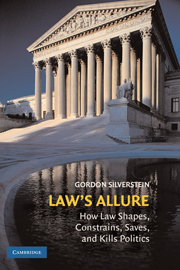Book contents
- Frontmatter
- Contents
- Acknowledgments
- LAW'S ALLURE
- Introduction: Law's Allure: The Juridification of American Politics and Public Policy
- PART I LAW'S ALLURE: WHY, WHY NOW, AND WHY IT MATTERS
- 1 Motives, Incentives, Patterns, and Process
- 2 Why Now? From May and May Not – To Must
- 3 Law Is Different: The Power of Precedent
- PART II LAW'S ALLURE: PATTERNS, PROCESS, AND CAUTIONARY TALES
- PART III LAW'S ALLURE: COSTS AND CONSEQUENCES
- Conclusion: The Promise and Peril of Law's Allure
- Bibliography
- Index
- References
3 - Law Is Different: The Power of Precedent
Published online by Cambridge University Press: 05 June 2012
- Frontmatter
- Contents
- Acknowledgments
- LAW'S ALLURE
- Introduction: Law's Allure: The Juridification of American Politics and Public Policy
- PART I LAW'S ALLURE: WHY, WHY NOW, AND WHY IT MATTERS
- 1 Motives, Incentives, Patterns, and Process
- 2 Why Now? From May and May Not – To Must
- 3 Law Is Different: The Power of Precedent
- PART II LAW'S ALLURE: PATTERNS, PROCESS, AND CAUTIONARY TALES
- PART III LAW'S ALLURE: COSTS AND CONSEQUENCES
- Conclusion: The Promise and Peril of Law's Allure
- Bibliography
- Index
- References
Summary
For policy entrepreneurs and politicians determined to advance their cause, it would seem that the choice of a judicial route rather than using the traditional political tools of bargaining, persuading, negotiating, and running election campaigns should simply be guided by matters of efficiency – which path will get me closer to my goal at the lowest cost? But law is different, and choosing a legal path generates risks that need to be considered. Judicial decisions may be political, but judicial decision making follows different rules and is driven by different incentives, limited by different constraints, and addressed to different audiences in a different language than is the political process. The way judges articulate, explain, and rationalize their choices and the way earlier decisions influence, shape, and constrain later judicial decisions are distinctly different from the patterns, practices, rhetoric, internal rules, and driving incentives that operate in the elected branches and among bureaucrats. These differences suggest that, although a legal strategy may be relatively successful in the short term, the judicial decisions and legal forms on which it relies can limit, direct, shape, and constrain those policies in the longer run in ways quite different from what might have been expected by those who embraced this approach in the first place.
After outlining a three-dimensional view of precedent, this chapter uses examples from cases involving slavery, religious liberty, racial discrimination, representation, and voting rights to illustrate both the ways in which legal decision making is different from ordinary political bargaining and how and why judicial precedent shapes and constrains policymaking and the political process itself.
- Type
- Chapter
- Information
- Law's AllureHow Law Shapes, Constrains, Saves, and Kills Politics, pp. 63 - 92Publisher: Cambridge University PressPrint publication year: 2009



